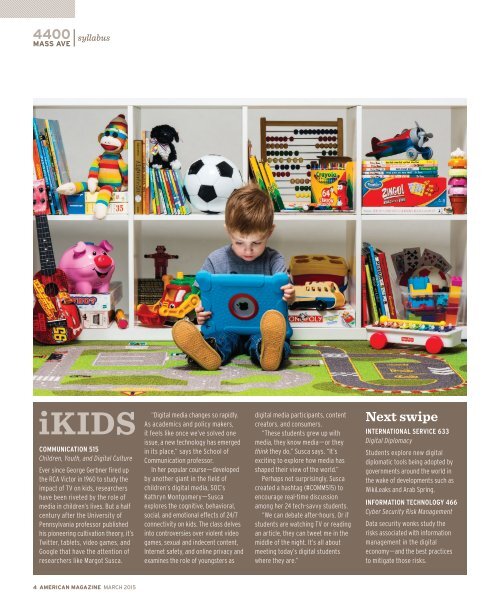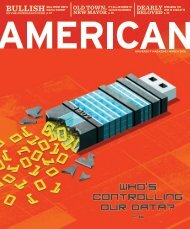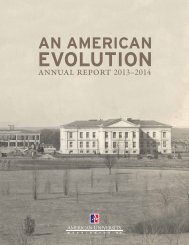American Magazine March 2015
This issue, meet DC Mayor Muriel Bowser, learn about the influx of post-9/11 veterans on college campuses across the country, hop on the Metro to Farragut North, and get to know some of AU's 600 Phoenix transplants. Also in the March issue: the psychology behind selfies, attorney Tom Goldstein's path to the Supreme Court, and cartoonist Tony Rubino's tools of the trade.
This issue, meet DC Mayor Muriel Bowser, learn about the influx of post-9/11 veterans on college campuses across the country, hop on the Metro to Farragut North, and get to know some of AU's 600 Phoenix transplants. Also in the March issue: the psychology behind selfies, attorney Tom Goldstein's path to the Supreme Court, and cartoonist Tony Rubino's tools of the trade.
You also want an ePaper? Increase the reach of your titles
YUMPU automatically turns print PDFs into web optimized ePapers that Google loves.
syllabus<br />
COMMUNICATION 515<br />
Children, Youth, and Digital Culture<br />
Ever since George Gerbner fired up<br />
the RCA Victor in 1960 to study the<br />
impact of TV on kids, researchers<br />
have been riveted by the role of<br />
media in children’s lives. But a half<br />
century after the University of<br />
Pennsylvania professor published<br />
his pioneering cultivation theory, it’s<br />
Twitter, tablets, video games, and<br />
Google that have the attention of<br />
researchers like Margot Susca.<br />
“Digital media changes so rapidly.<br />
As academics and policy makers,<br />
it feels like once we’ve solved one<br />
issue, a new technology has emerged<br />
in its place,” says the School of<br />
Communication professor.<br />
In her popular course—developed<br />
by another giant in the field of<br />
children’s digital media, SOC’s<br />
Kathryn Montgomery—Susca<br />
explores the cognitive, behavioral,<br />
social, and emotional effects of 24/7<br />
connectivity on kids. The class delves<br />
into controversies over violent video<br />
games, sexual and indecent content,<br />
Internet safety, and online privacy and<br />
examines the role of youngsters as<br />
digital media participants, content<br />
creators, and consumers.<br />
“These students grew up with<br />
media, they know media—or they<br />
think they do,” Susca says. “It’s<br />
exciting to explore how media has<br />
shaped their view of the world.”<br />
Perhaps not surprisingly, Susca<br />
created a hashtag (#COMM515) to<br />
encourage real-time discussion<br />
among her 24 tech-savvy students.<br />
“We can debate after-hours. Or if<br />
students are watching TV or reading<br />
an article, they can tweet me in the<br />
middle of the night. It’s all about<br />
meeting today’s digital students<br />
where they are.”<br />
Next swipe<br />
INTERNATIONAL SERVICE 633<br />
Digital Diplomacy<br />
Students explore new digital<br />
diplomatic tools being adopted by<br />
governments around the world in<br />
the wake of developments such as<br />
WikiLeaks and Arab Spring.<br />
INFORMATION TECHNOLOGY 466<br />
Cyber Security Risk Management<br />
Data security wonks study the<br />
risks associated with information<br />
management in the digital<br />
economy—and the best practices<br />
to mitigate those risks.<br />
4 AMERICAN MAGAZINE MARCH <strong>2015</strong>

















